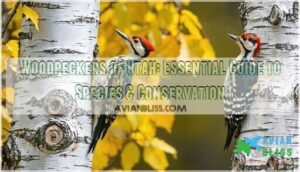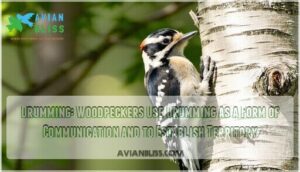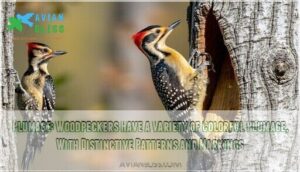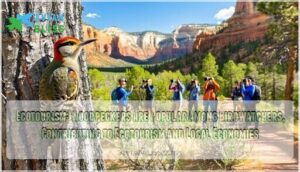This site is supported by our readers. We may earn a commission, at no cost to you, if you purchase through links.

These remarkable birds showcase incredible adaptations – their specialized beaks can drill through bark with surgical precision, while their stiff tail feathers work like a built-in kickstand for vertical climbing.
Utah’s woodpeckers aren’t just pretty faces; they’re hardworking pest controllers, gobbling up thousands of tree-damaging insects each year while creating essential nesting cavities for other wildlife.
Whether you’re hiking through aspen groves or exploring red rock canyons, these feathered carpenters are busy shaping Utah’s ecosystems in ways that might surprise you.
Table Of Contents
- Key Takeaways
- Behavior and Characteristics of Woodpeckers
- Importance of Woodpeckers in Utah Ecosystems
- Conservation of Woodpeckers in Utah
- Frequently Asked Questions (FAQs)
- What does a Utah woodpecker look like?
- How many woodpeckers are in Utah?
- Is it good to have woodpeckers around?
- What is the rarest type of woodpecker?
- What woodpecker species migrate through Utah seasonally?
- How do woodpeckers choose their nesting sites?
- What foods attract woodpeckers to backyard feeders?
- When is peak woodpecker breeding season?
- Which woodpeckers are most common in cities?
- Conclusion
Key Takeaways
- You’ll discover eight unique woodpecker species across Utah’s diverse habitats, from mountain forests to desert canyons, each with specialized adaptations like precision drilling beaks and tail feathers that work as climbing kickstands.
- You’re witnessing nature’s pest control in action when woodpeckers consume over 1,000 tree-boring insects daily, protecting Utah’s forests from bark beetles, wood-boring larvae, and other destructive pests without chemicals.
- You’ll recognize different species by their distinctive drumming patterns and colorful plumage features like bold black-and-white markings, red patches, and unique identifiers such as the Lewis’s Woodpecker’s pink belly.
- You can support woodpecker conservation by participating in reforestation efforts with native trees, joining citizen science projects, and practicing responsible birding to protect nesting sites and maintain healthy ecosystems.
Behavior and Characteristics of Woodpeckers
You’ll notice woodpeckers communicate through rhythmic drumming that echoes across Utah’s forests, with each species creating unique patterns to claim territory and attract mates.
Their striking plumage features bold black-and-white patterns, vibrant red patches, and distinctive markings that make identification easier once you know what to look for.
Drumming: Woodpeckers Use Drumming as a Form of Communication and to Establish Territory
When you hear rapid-fire drumming echoing through Utah’s forests, you’re witnessing woodpecker communication in action.
Each Utah woodpecker species creates unique sound characteristics through drumming frequency variations that serve specific purposes in territory defense and mate attraction.
Here’s how Utah woodpeckers use drumming patterns:
- Territory Defense – Males drum loudly to warn rivals away from nesting sites
- Mate Attraction – Specific rhythms signal readiness to breed during spring
- Species Variation – Each species has distinct drumming speeds and patterns
- Drumming Purpose – Communication replaces vocal calls in woodpecker behavior
- Sound Identification – Experienced birders recognize species by drumming alone
This woodpecker drumming serves as their primary language across Utah’s diverse habitats.
Plumage: Woodpeckers Have a Variety of Colorful Plumage, With Distinctive Patterns and Markings
Utah woodpeckers showcase stunning plumage coloration that makes bird identification easier for observers.
You’ll notice distinct feather patterns like the Red-naped Sapsucker’s bold red throat patch and the Northern Flicker’s spotted breast.
Sexual dimorphism appears clearly in most woodpecker species—males typically display brighter red crowns while females show more subdued markings.
Juvenile plumage often differs from adults, with duller colors and less defined patterns.
These remarkable birds use camouflage effectively, blending black-and-white striped backs against tree bark.
From the Lewis’s Woodpecker’s pink belly to the Downy’s crisp white underparts, each species exhibits unique woodpecker identification features that distinguish them in Utah’s diverse forests.
Some species achieve their coloration through melanin and carotenoids, resulting in a spectrum of browns, blacks, yellows, oranges, and reds.
Importance of Woodpeckers in Utah Ecosystems
You’ll find that woodpeckers serve as Utah’s natural pest control team, consuming thousands of harmful insects and larvae that threaten forest health.
These birds also boost local economies by attracting birdwatchers and nature enthusiasts who contribute millions to Utah’s ecotourism industry, which is a significant part of the state’s revenue, and they play a crucial role in maintaining the forest health.
Pest Control: Woodpeckers Help Control Populations of Insects and Larvae That Can Damage Trees
Utah’s woodpeckers serve as nature’s pest controllers through their specialized feeding habits.
These birds actively hunt insects and larvae that threaten forest health, making them essential partners in natural pest control.
Woodpeckers keep Utah’s forests healthy by feasting on insects that threaten trees.
Utah’s woodpeckers work as nature’s exterminators, eliminating forest-destroying pests with remarkable precision.
Your local woodpecker species provide critical insect consumption services by targeting these destructive pests:
- Bark beetles – American Three-toed Woodpeckers eliminate up to 40% of these forest destroyers
- Wood-boring larvae – Found deep within tree bark, accessed by specialized beaks
- Carpenter ants – Controlled through persistent foraging in damaged wood
- Emerald ash borers – Invasive beetles substantially reduced by woodpecker diet patterns
This natural pest control protects Utah’s forests without chemicals, demonstrating how woodpeckers’ diet directly supports ecosystem balance.
Woodpeckers also create nesting sites, which other species often use.
Ecotourism: Woodpeckers Are Popular Among Birdwatchers, Contributing to Ecotourism and Local Economies
Birdwatching Benefits extend far beyond personal enjoyment when you explore Utah’s woodpecker habitats.
Your visits create significant Economic Impact, with birders contributing billions annually to local economies through lodging, equipment, and guided tours.
This Sustainable Tourism supports Habitat Preservation efforts while fostering Community Involvement in conservation.
Utah birds like Northern Flickers attract thousands of bird watching enthusiasts yearly, strengthening Utah wildlife protection and Utah bird habitats preservation.
The industry sees substantial market growth, with projections estimating it will reach $95.22 billion by 2030.
Conservation of Woodpeckers in Utah
You can help protect Utah’s woodpeckers by supporting reforestation efforts that plant native trees, which create the nesting sites and food sources these birds need to survive.
Getting involved in local conservation education programs also makes a real difference, since public awareness leads to better habitat protection and funding for woodpecker research.
Reforestation: Planting Native Tree Species to Provide Suitable Nesting and Foraging Habitats
When planning woodpecker habitat restoration, you’ll want to focus on Native Tree Selection that matches Utah’s diverse ecosystems.
Strategic reforestation creates long-term benefits for local bird populations and forest health.
Consider these essential elements for successful habitat restoration:
- Oak and aspen groves – These native species provide excellent nesting sites and attract insects that woodpeckers love
- Diverse age classes – Plant saplings alongside mature trees to guarantee continuous habitat availability
- Dead tree retention – Leave snags standing as they’re prime real estate for cavity-nesting woodpeckers
- Community Involvement – Engage local volunteers in planting efforts to expand restoration impact
- Long-Term Monitoring – Track woodpecker populations to measure Habitat Restoration Success over time
Climate Change Impact makes native plants even more vital for Utah forests.
These species adapt better to changing conditions while supporting woodpecker attraction through reliable food sources and nesting opportunities.
Idaho also hosts ten woodpecker species, showcasing regional diversity.
Education and Awareness: Promoting Awareness About The Importance of Woodpeckers and Their Conservation Needs
Beyond planting trees, you’ll find that education builds stronger woodpecker conservation efforts.
Community outreach programs teach responsible birding practices while citizen science projects engage volunteers in habitat preservation monitoring.
Educational programs connect people with Utah bird species, fostering lasting conservation commitment.
| Conservation Activity | Community Impact | Participation Method |
|---|---|---|
| Citizen Science | Data collection for woodpecker Utah populations | Submit sightings through apps |
| Educational Programs | Increased awareness of bird conservation tips | Attend workshops and seminars |
| Responsible Birding | Protected nesting sites and reduced disturbance | Follow ethical birding guidelines |
The table outlines various conservation activities, including Citizen Science, Educational Programs, and Responsible Birding, each with its unique community impact and participation method, highlighting the importance of community outreach in woodpecker conservation.
Frequently Asked Questions (FAQs)
What does a Utah woodpecker look like?
You’ll spot Utah’s woodpeckers by their distinctive black-and-white patterns, varied sizes from tiny Downy Woodpeckers to large Northern Flickers.
They also have colorful accents like red caps, pink bellies, or yellow patches depending on species.
How many woodpeckers are in Utah?
Like puzzle pieces scattered across nature’s canvas, you’ll discover nine distinct woodpecker species calling Utah home year-round or seasonally, each adding their unique drumbeat to the state’s wild symphony.
Is it good to have woodpeckers around?
Yes, you’ll want woodpeckers around! They’re nature’s pest control, eating thousands of harmful insects that damage trees.
They also create nesting holes for other wildlife, helping maintain healthy forest ecosystems in your area, which is a key part of being nature’s pest control.
What is the rarest type of woodpecker?
Woodpecker conservation hangs by a thread in some cases.
The rarest woodpecker globally is the Ivory-billed Woodpecker, thought extinct since the 1940s despite occasional unconfirmed sightings, making it nature’s most elusive phantom.
What woodpecker species migrate through Utah seasonally?
Several woodpecker species migrate through Utah seasonally.
You’ll find Red-naped Sapsuckers and Williamson’s Sapsuckers passing through during spring and fall migrations, while others like Lewis’s Woodpeckers move seasonally between different elevations and habitats, which involves seasonally adjusting to new environments.
How do woodpeckers choose their nesting sites?
You’ll find woodpeckers select nesting sites based on tree health, cavity availability, and food sources nearby.
They prefer dead or diseased trees that’re easier to excavate while avoiding areas with heavy predator activity.
What foods attract woodpeckers to backyard feeders?
Sure, you’ll think you’re running a gourmet restaurant when suet, sunflower seeds, peanuts, and mealworms turn your feeder into woodpecker central. These protein-rich treats satisfy their high-energy needs perfectly.
When is peak woodpecker breeding season?
Peak breeding season occurs from April through July when you’ll hear increased drumming and territorial calls.
Most species begin courtship in early spring, with eggs laid between May and June for ideal nesting success.
Which woodpeckers are most common in cities?
As you walk through your neighborhood, you’ll spot Downy and Hairy Woodpeckers adapting to urban life.
These hardy birds frequent backyard feeders, city parks, and tree-lined streets, making them Utah’s most common urban woodpeckers.
Conclusion
Scientists estimate that a single woodpecker can consume over 1,000 tree-boring insects daily, making these birds incredibly valuable to Utah’s forest health.
The eight woodpeckers of Utah serve as nature’s pest control specialists while creating essential habitat for dozens of other species.
You’ll find these remarkable birds adapting to everything from high-elevation forests to desert canyons, each playing a pivotal role in maintaining ecosystem balance.
Protecting their habitats guarantees these feathered carpenters continue their essential work across Utah’s diverse landscapes.
- https://digitalcommons.usu.edu/cgi/viewcontent.cgi?article=2002&context=extension_histall
- https://wildaboututah.org/acorn-woodpeckers/
- http://www.utahbirds.org/birdsofutah/ProfilesD-K/DownyWoodpecker.htm
- https://avibirds.com/woodpeckers-of-utah/
- https://bonderman-station.utah.edu/about/natural-history/birds/s-nuchalis-sapsucker.php








